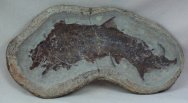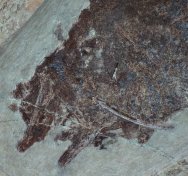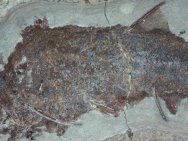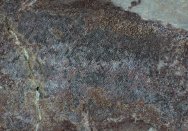Cheiracanthus
latus
Infraphylum
Gnathostomata, Class Acanthodii, Order Acanthodiformes, Family Cheiracanthidae
Geological
Time: Middle Devonian, about 390 million years ago
Size: Fish
fossil is 120 mm in length (tip of nose to tip of tail along backbone)
on a 60 mm by 150 mm matrix
Fossil Site:
Tynet Burn, Elgin, Scotland
Fossil Code:
UKF239
Price: Sold
 Description:
The Acanthodians are jaw-bearing fish who still are the subject
of dispute over their systematic position. Most possessed highly-advanced,
spindle-shaped bodies thought to have made them swift swimmers.
The body was covered in small mosaic-like scales. They possessed
small Description:
The Acanthodians are jaw-bearing fish who still are the subject
of dispute over their systematic position. Most possessed highly-advanced,
spindle-shaped bodies thought to have made them swift swimmers.
The body was covered in small mosaic-like scales. They possessed
small 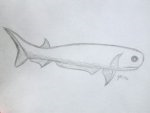 teeth which were typically confined to the lower jaw; some
were toothless. The feature they all share in common is the fact
that all fins other than the caudal are supported by massive
spines formed of dentine. Indeed, the name Acanthodii is derived
from the Greek word for spine. The oldest acanthodian lived during
the late Ordovician. They reached their peak during the Devonian,
and became extinct during the Great Dying of the end-Permian
extinction. This well-preserved example is known as Cheiracanthus,
a name that means “hand spine”. Unlike many acanthodians
this one had a single dorsal fin and was more stocky of build,
hence the specific name latus, meaning wide. While the head is
indistinct, the fine scales and spines are very much on display.
Full specimens such as this one are only found in Scotland ,
but distinctive scales have been found worldwide. teeth which were typically confined to the lower jaw; some
were toothless. The feature they all share in common is the fact
that all fins other than the caudal are supported by massive
spines formed of dentine. Indeed, the name Acanthodii is derived
from the Greek word for spine. The oldest acanthodian lived during
the late Ordovician. They reached their peak during the Devonian,
and became extinct during the Great Dying of the end-Permian
extinction. This well-preserved example is known as Cheiracanthus,
a name that means “hand spine”. Unlike many acanthodians
this one had a single dorsal fin and was more stocky of build,
hence the specific name latus, meaning wide. While the head is
indistinct, the fine scales and spines are very much on display.
Full specimens such as this one are only found in Scotland ,
but distinctive scales have been found worldwide.
Also
see: Paleozoic
Fish Fossils |
|


